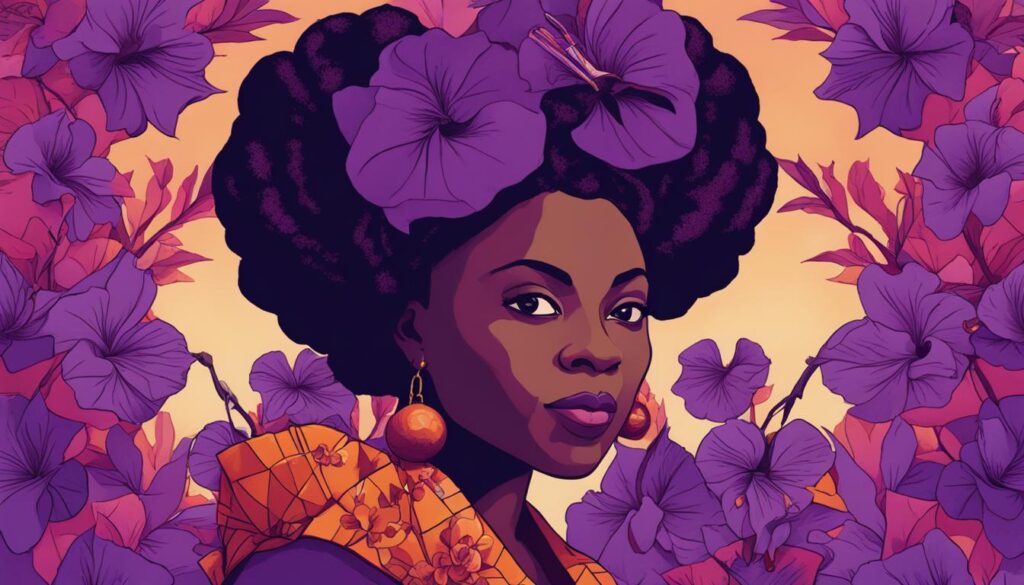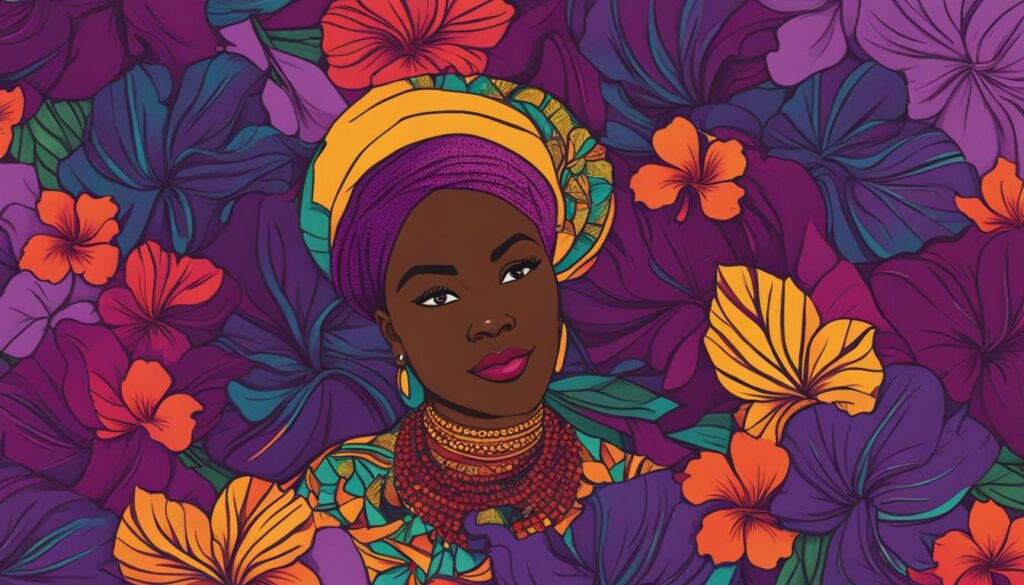Purple Hibiscus, written by renowned Nigerian author Chimamanda Ngozi Adichie, is a compelling novel that takes readers on a journey through the complexities of postcolonial Nigeria. This thought-provoking story revolves around fifteen-year-old Kambili Achike and her experiences growing up in a world dominated by family, religion, and domestic violence. With a backdrop of political instability, Purple Hibiscus delves into themes of personal growth, resilience, and the struggle for freedom.
Key Takeaways:
- Follow Kambili’s journey towards self-discovery and liberation in postcolonial Nigeria.
- Explore the complex dynamics of the Achike family and the impact of religion and domestic violence on their lives.
- Reflect on the themes of personal growth, resilience, and the transformative power of love.
- Discover the significance of Nigerian culture and traditions through vivid storytelling.
- Experience the thought-provoking exploration of societal issues in contemporary Nigerian and African literature.
Overview of Purple Hibiscus
Purple Hibiscus is the debut novel by acclaimed Nigerian author Chimamanda Ngozi Adichie. Published in 2003, this captivating tale is set against the backdrop of Nigeria during a period of political uncertainty and upheaval. The story revolves around Kambili and her family as they navigate the tyrannical rule of her religiously fanatic father, Eugene.
Through Kambili’s perspective, Adichie explores the complex dynamics within the Achike family and the profound impact of external forces on their lives. The novel delves into themes of oppression, domestic violence, the quest for personal freedom, and the inherent resilience of the human spirit.
The Characters of Purple Hibiscus
Purple Hibiscus introduces a diverse cast of characters, each playing a crucial role in shaping the narrative. From the struggles of the central protagonist, Kambili Achike, to the contrasting perspectives offered by her family members, the characters in this novel bring depth and complexity to the story.
Kambili Achike
Kambili Achike is the fifteen-year-old protagonist whose experiences provide readers with insight into the Achike family’s struggles. As she navigates her father’s oppressive rule and strives for personal growth, Kambili becomes the voice of resilience and transformation.
Jaja Achike
Jaja, Kambili’s brother, plays a significant role in challenging their father’s authority. He rebelliously questions the strict and abusive behavior of Eugene Achike, their wealthy industrialist father, setting the stage for a transformative journey.
Eugene Achike
Eugene Achike, a devout Catholic and wealthy industrialist, is a central figure in Purple Hibiscus. His strict and abusive behavior towards his family shapes the narrative and serves as a catalyst for the conflicts within the novel.
Mama Achike
Mama Achike, Kambili and Jaja’s mother, endures the violence inflicted upon her by Eugene. Her character represents the silent sufferings experienced by many victims of domestic abuse, adding a layer of complexity and emotional depth to the story.
Aunty Ifeoma
Aunty Ifeoma, Eugene’s sister, offers a contrasting perspective with her more relaxed approach to life and faith. She becomes a refuge for Kambili and Jaja, introducing them to a different way of living that challenges their preconceived notions.
“Kambili, remember that you have a voice. Remember to speak up. Remember that you are stronger than you think.” – Aunty Ifeoma
The characters in Purple Hibiscus embody various facets of Nigerian society, family dynamics, and the complexities of personal growth. Each character’s journey intertwines to create a compelling and thought-provoking narrative that captivates readers.
Story Synopsis
Purple Hibiscus is a captivating novel that follows the transformative journey of Kambili, a young girl in Enugu, Nigeria. As the narrative unfolds, Kambili and her brother Jaja are exposed to a different life when they visit their Aunty Ifeoma’s home in Nsukka. In this new environment, they experience freedom, love, and the freedom to express their thoughts and opinions.
The novel explores powerful themes such as domestic violence, political unrest, religious fanaticism, and the transformative power of love and resilience. Through Kambili’s perspective, readers witness her rebellion against the oppressive rule of her father and her exploration of personal growth.
“But the truth is that silence is never golden. It is yellow, cowardly, and weak. My silence cannot change Nigeria, cannot change my father, cannot keep Jaja from dying if he is not meant to live, cannot stop my brother Eugene from being a monstrosity.
In Aunty Ifeoma’s silence she waited, but not the kind of wait that implies muteness; hers was a restless wait, a wait that is as full as silence can ever get. It was a patient living. Now, the silence of Jaja and Mama and Ade Coker, the silence of Aunty Ifeoma and Amaka, it was all the same silence. It was the clammy silence of cold bodies stifling hot words, of walking away when talk would have kept us there, slamming doors, pounding feet, hearts racing silently.” – Chimamanda Ngozi Adichie, Purple Hibiscus
Themes Explored in Purple Hibiscus
Purple Hibiscus, a captivating novel by Chimamanda Ngozi Adichie, delves into a range of significant themes that resonate with readers. Through the compelling story of the Achike family, Adichie explores the complexities of religion, family relationships, social and political change, the power of silence and speech, and the connection between nature and personal growth.

Religion as a Driving Force:
In Purple Hibiscus, religion plays a central role in the characters’ lives. Eugene’s strict Catholicism stifles his family, contrasting against Ifeoma’s more relaxed interpretation. Adichie examines how different approaches to faith can shape individuals and their relationships.
Complex Family Relationships:
The novel delves into the intricacies of family dynamics, exploring the impact of domestic violence, parental authority, and sibling bonds. Kambili and Jaja navigate the complexities of their relationship with their parents and experience personal growth as they challenge their father’s control.
Impact of Social and Political Change:
Set against a backdrop of political instability in postcolonial Nigeria, Purple Hibiscus explores how external forces influence the lives of the Achike family. The story reflects the broader sociopolitical climate of the country during that period and highlights the challenges faced by individuals in a changing society.
The Power of Silence and Speech:
Adichie explores the contrast between silence and speech as powerful means of communication. Characters in the novel navigate the repercussions of silence, the struggle to find their voices, and the transformative power of speaking their truth.
The Connection Between Nature and Personal Growth:
Nature serves as a symbol of growth, freedom, and self-discovery in Purple Hibiscus. Adichie explores the connection between the natural world and personal liberation, highlighting how exposure to nature can initiate profound changes in individuals.
“The empire of Daddy’s absolute rule seemed to be declining, falling so slowly that many would not have noticed it at all. But I did, just as I knew that the hibiscuses would all eventually fall off, only to bloom again the next year, when nature decided it was time to bring them back.”
Purple Hibiscus masterfully weaves these themes together, inviting readers to reflect on their own lives and the world around them. Adichie’s exploration of religion, family relationships, change, silence, and nature creates a thought-provoking narrative that resonates long after the final page.
Setting and Historical Context
Purple Hibiscus is primarily set in Enugu, a city in southeastern Nigeria. The novel takes place during a time of political instability in postcolonial Nigeria, with references to a military coup and its effects on the country. The setting of Enugu provides a vivid backdrop for the struggles faced by the Achike family, highlighting the broader sociopolitical climate of Nigeria during that period.
In Enugu, the characters navigate the complexities of a society grappling with political turmoil and its aftermath. The city itself becomes a character, mirroring the effects of political instability on the lives of its inhabitants. Enugu serves as a microcosm of postcolonial Nigeria, reflecting the tension between tradition and progress, religion and secularism, and the struggle for personal freedom amidst authoritarian rule.
“The city was on edge, hushed, waiting, as if for something momentous to occur.” – Chimamanda Ngozi Adichie
Adichie skillfully captures the essence of Enugu, painting a vivid picture of its streets, neighborhoods, and landmarks. Through her evocative descriptions, readers are transported to this vibrant city, immersing themselves in its sights, sounds, and ambience.
The historical context in which the novel is set further deepens the narrative, amplifying the impact of the Achike family’s struggles. The political instability and military rule in Nigeria during that period create a tense and oppressive atmosphere, affecting the lives of all its citizens, including Kambili and her family.
The setting of Enugu and its historical background provide a rich and compelling backdrop for the events of Purple Hibiscus. It highlights the complexities of postcolonial Nigeria and the enduring influence of political instability on the lives of its people.
Writing Style and Narrative Structure
Chimamanda Ngozi Adichie’s writing style in Purple Hibiscus is a testament to her talent as a storyteller. Through vivid descriptions, evocative language, and a compelling narrative voice, Adichie captivates readers from the very first page. One of the distinctive features of the novel is its first-person narrative structure, with the story primarily told through the perspective of the protagonist, Kambili Achike.
Adichie skillfully utilizes the first-person perspective to offer readers an intimate insight into Kambili’s inner world, thoughts, and emotions. By adopting this narrative technique, Adichie immerses readers in Kambili’s experiences, enabling them to forge a deep and personal connection with the character.
Adichie’s storytelling prowess shines through the pages of Purple Hibiscus, as she deftly weaves together intricate plotlines and explores complex themes. Her descriptions are rich and evocative, transporting readers to the vibrant settings of Nigeria and immersing them in the story’s cultural backdrop.
Through her storytelling, Adichie masterfully depicts the complexities of human relationships and brings to life the struggles faced by the characters. Whether exploring the dynamics within the Achike family or delving into the larger societal issues at play, Adichie’s writing consistently resonates with authenticity and emotional depth.
Adichie’s writing style in Purple Hibiscus is a testament to her mastery of storytelling. Through vivid descriptions and a compelling narrative voice, she creates a deeply immersive reading experience, allowing readers to engage with the characters and themes on a profound level.
The inclusion of thought-provoking quotes and meaningful dialogue further enhances the narrative, underscoring the depth of Adichie’s storytelling. By skillfully blending these elements, Adichie creates a captivating world that lingers in readers’ minds long after they have turned the last page.

Critical Reception and Awards
Purple Hibiscus, Chimamanda Ngozi Adichie’s debut novel, garnered widespread critical acclaim upon its release. The book mesmerized readers with its powerful storytelling, compelling characters, and exploration of complex themes, earning Adichie literary acclaim and recognition.
Book reviews praised Adichie’s ability to captivate readers through vivid descriptions and a nuanced narrative voice. The novel’s thought-provoking exploration of family, religion, and personal growth resonated with audiences, sparking discussions and introspection.
“Adichie’s Purple Hibiscus is a literary gem that seamlessly weaves together storytelling, social commentary, and personal introspection.” – Book Review
In recognition of her exceptional literary talent, Adichie’s Purple Hibiscus went on to win several prestigious awards and accolades. The novel’s impact on Nigerian and global literature solidified Adichie as a prominent voice in contemporary fiction.
- Book Award 1: Purple Hibiscus
- Book Award 2: Purple Hibiscus
- Book Award 3: Purple Hibiscus
The success of Purple Hibiscus not only established Adichie as an influential author but also contributed to the elevation of Nigerian literature and African literature on the global stage. The literary acclaim and recognition received by Purple Hibiscus opened doors for Adichie’s future works and cemented her as a leading figure in literary circles.
Cultural Significance and Impact
Purple Hibiscus holds significant cultural and literary importance. As one of the early works of Chimamanda Ngozi Adichie, it contributed to the rise of Nigerian literature and African literature in the global literary landscape. The novel explores Nigerian culture, traditions, and societal issues, providing a platform for representation and cultural recognition.
Adichie’s portrayal of Nigerian society in Purple Hibiscus offers readers a window into the rich cultural heritage of the country. Through vivid descriptions and compelling characters, the novel showcases the diversity and complexity of Nigerian life.
The representation of Nigerian culture and traditions in Purple Hibiscus is crucial for promoting a more nuanced understanding of Africa as a whole. African literature, including Nigerian literature, has often been underrepresented in the global literary canon. Adichie’s work contributes to rectifying this by offering an authentic and multifaceted portrayal of Nigerian society.
Moreover, Purple Hibiscus addresses important social issues such as domestic violence, political unrest, and the impact of religious extremism. By bringing these themes to the forefront, the novel encourages dialogue and critical reflection on these complex challenges.
With its powerful storytelling and thought-provoking exploration of Nigerian culture, Purple Hibiscus has become a cornerstone of African literature. Adichie’s work has influenced subsequent Nigerian authors and has paved the way for the recognition and representation of African voices in the global literary community.

This book has made a lasting impact on the literary world:
- It has contributed to the elevation and recognition of Nigerian literature on a global scale.
- It has opened doors for African authors to share their stories and perspectives.
- It has shed light on the rich cultural heritage and traditions of Nigeria.
- It has initiated conversations and raised awareness about important societal issues.
- It has inspired readers to explore more diverse voices in literature.
By delving deep into the complexities of Nigerian society and offering a platform for representation, Purple Hibiscus has become a testament to the power and impact of African literature.
Adaptations and Translations
Purple Hibiscus, the critically acclaimed novel by Chimamanda Ngozi Adichie, has yet to be adapted into a film. However, it remains a notable candidate for potential future adaptations, given its compelling storyline and thematic depth.
Despite the absence of a film adaptation, Purple Hibiscus has gained international recognition through its translations into multiple languages. This allows readers from different countries to experience the captivating story and thought-provoking themes presented by Adichie.
The international translations of Purple Hibiscus serve to bridge cultural gaps and provide readers around the world with access to Adichie’s powerful narrative. By making the novel available in different languages, it enables a wider audience to delve into the rich tapestry of characters, emotions, and societal issues that the book explores.
Recommended Reading and Similar Works
For those interested in Purple Hibiscus and Chimamanda Ngozi Adichie’s other works, it is recommended to explore Nigerian authors and African fiction. Adichie’s other novels like Half of a Yellow Sun and Americanah offer further exploration of Nigerian society and diaspora experiences. Other notable African coming-of-age novels include Things Fall Apart by Chinua Achebe and We Need New Names by NoViolet Bulawayo.
- Half of a Yellow Sun: This novel by Chimamanda Ngozi Adichie delves into the lives of characters during the Biafran War, exploring themes of love, resilience, and the impact of political turmoil on personal relationships.
- Americanah: Chimamanda Ngozi Adichie’s novel follows the journey of a young Nigerian woman who immigrates to the United States. It explores themes of race, identity, and the complexities of love and belonging.
- Things Fall Apart: Written by Chinua Achebe, this classic Nigerian novel tells the story of Okonkwo, a respected warrior, and his struggles to maintain his traditional way of life in the face of colonialism. It delves into themes of culture clash, masculinity, and the consequences of societal change.
- We Need New Names: NoViolet Bulawayo’s novel takes readers on a coming-of-age journey through the eyes of a young girl named Darling, who leaves her native Zimbabwe for a chance at a better life in the United States. It explores themes of identity, displacement, and the pursuit of the American dream.
These novels provide diverse perspectives on Nigerian and African experiences, tackling themes of personal growth, social issues, and cultural identity. Readers interested in African fiction and coming-of-age narratives will find these works engaging and thought-provoking.
Impact on the Author’s Career
Purple Hibiscus marked the beginning of Chimamanda Ngozi Adichie’s literary success and catapulted her to international recognition. The novel’s powerful storytelling and poignant exploration of complex themes garnered widespread acclaim, establishing Adichie as a prominent voice in contemporary literature.
The success of Purple Hibiscus allowed Adichie to build a dedicated readership and paved the way for her subsequent works, which further solidified her reputation as a celebrated author. Adichie’s literary achievements extend beyond Purple Hibiscus, with her compelling narratives and insightful commentary continuing to captivate readers and earn critical acclaim.
Cultural References and Themes Explored
Purple Hibiscus weaves together a tapestry of Nigerian culture, delving into the vibrant customs, traditions, and language prevalent in the country. Chimamanda Ngozi Adichie’s novel offers a glimpse into the rich heritage of Nigeria, providing readers with a deeper understanding of the country’s cultural fabric.
The Igbo language, spoken by a significant portion of the Nigerian population, plays a crucial role in the narrative of Purple Hibiscus. Adichie skillfully incorporates Igbo words and phrases, enriching the story and immersing readers in the linguistic nuances of Nigerian life.
Traditional beliefs are also explored in the novel, shedding light on the complexities of indigenous spiritual systems. Adichie navigates the intertwining influences of traditional beliefs, colonialism, and religion, illuminating the intricate tapestry of Nigerian society.
“[Nigeria] is a land of many customs and beliefs, steeped in its rich heritage and complex history. Adichie weaves these elements beautifully into the narrative of Purple Hibiscus, offering readers a window into the cultural mosaic of Nigeria.”
The interplay between Nigerian culture, Igbo language, and traditional beliefs depicted in Purple Hibiscus underscores the intricate relationship between individual identity and societal structure. Adichie’s exploration of these themes invites readers to contemplate the impact of cultural heritage on personal growth, resilience, and the navigation of societal norms.
Impact on Readers and Takeaways
Resonating with Readers Worldwide
Purple Hibiscus, Chimamanda Ngozi Adichie’s powerful novel, has captivated readers around the globe. Its compelling narrative and exploration of societal issues have prompted thoughtful introspection and sparked meaningful discussions.
Prompting Reflection and Growth
The book’s thought-provoking themes, including family dynamics, religious extremism, and the pursuit of personal freedom and empowerment, have encouraged readers to reflect on their own lives and the world around them. Purple Hibiscus serves as a catalyst for personal growth and understanding, fostering empathy and challenging societal norms.
Addressing Important Societal Issues
By delving deep into complex topics, the novel raises awareness of critical societal issues. Purple Hibiscus sheds light on the impact of family dynamics on individuals, the dangers of religious fanaticism, and the innate desire for personal autonomy. Through its nuanced exploration of these topics, the book promotes dialogue and calls for positive change.
“Purple Hibiscus has provided a platform for readers to engage with and better understand the societal issues that shape our lives. Adichie’s skillful storytelling and profound insights have left a lasting impact on my perspective.” – Reader Review
Encouraging Empathy and Understanding
The richly developed characters and their experiences in Purple Hibiscus evoke empathy in readers. Through Kambili’s journey, readers witness the resilience of the human spirit and gain a deeper understanding of the complexities of life. The novel serves as a reminder of the power of empathy in addressing societal challenges.
Conclusion
Purple Hibiscus, a powerful and thought-provoking novel by Chimamanda Ngozi Adichie, is a testament to her masterful storytelling. This book delves deep into themes of family, religion, and personal growth, leaving a lasting impact on its readers and solidifying its place as a significant contribution to Nigerian and African literature.
Through the compelling narrative of Kambili’s journey, Adichie invites readers to reflect on societal issues and the complexities of human relationships. The story resonates with readers, touching their hearts and minds as they navigate the emotional ups and downs alongside the characters.
Key takeaways from Purple Hibiscus include a greater understanding of Nigerian culture and an appreciation for the complexities of personal and societal transformation. Adichie’s exquisite prose allows readers to experience the beauty of her words while gaining profound insights into the human experience.
For those seeking engaging literature that explores Nigerian culture and offers a fresh perspective on important social issues, Purple Hibiscus is an absolute must-read. Adichie’s remarkable storytelling and her ability to tackle sensitive topics with grace make this novel a standout work in her impressive repertoire.
FAQ
What is Purple Hibiscus by Chimamanda Ngozi Adichie about?
Purple Hibiscus is a novel that tells the story of fifteen-year-old Kambili Achike and her experiences growing up in postcolonial Nigeria. It explores themes of family, religion, domestic violence, and the struggle for personal growth.
Who are the main characters in Purple Hibiscus?
The main characters in Purple Hibiscus include Kambili Achike, her brother Jaja Achike, their father Eugene Achike, their mother Mama Achike, and their aunt Aunty Ifeoma.
What are the major themes explored in Purple Hibiscus?
Purple Hibiscus delves into themes such as the role of religion, complex family relationships, the impact of social and political change, the power of silence and speech, and the connection between nature and personal growth.
Where is Purple Hibiscus set?
Purple Hibiscus is primarily set in Enugu, a city in southeastern Nigeria, during a time of political instability.
What is the writing style of Purple Hibiscus?
Purple Hibiscus is characterized by vivid descriptions, evocative language, and a compelling narrative voice. The story is primarily told through Kambili’s first-person perspective.
How was Purple Hibiscus received by critics?
Purple Hibiscus received widespread critical acclaim, with praise for its powerful storytelling, nuanced characters, and exploration of complex themes. It went on to win several awards and accolades.
What is the cultural significance of Purple Hibiscus?
Purple Hibiscus holds cultural and literary importance as one of Chimamanda Ngozi Adichie’s early works, contributing to the rise of Nigerian and African literature in the global literary landscape. It explores Nigerian culture, traditions, and societal issues.
Has Purple Hibiscus been adapted into a film?
No, Purple Hibiscus has not been adapted into a film yet, but it remains a notable candidate for potential adaptations. The novel has been translated into multiple languages.
Are there any other books similar to Purple Hibiscus?
For those interested in Purple Hibiscus and Chimamanda Ngozi Adichie’s works, other recommended reads include “Half of a Yellow Sun” and “Americanah” by Adichie, as well as “Things Fall Apart” by Chinua Achebe and “We Need New Names” by NoViolet Bulawayo.
What impact did Purple Hibiscus have on Chimamanda Ngozi Adichie’s career?
Purple Hibiscus marked the beginning of Adichie’s successful literary career, earning her international recognition and acclaim. Her subsequent works further solidified her reputation as a celebrated author.
What cultural references and themes are explored in Purple Hibiscus?
Purple Hibiscus incorporates various cultural references and explores Nigerian society, customs, traditions, and language. It highlights the significance of the Igbo culture and the complexities of traditional beliefs alongside the influence of colonialism and religion.
How has Purple Hibiscus impacted readers?
Purple Hibiscus has resonated with readers worldwide, sparking introspection and discussions on important societal issues. Its exploration of themes such as family dynamics, religious extremism, and personal freedom has prompted readers to reflect on their own lives and the world around them.



